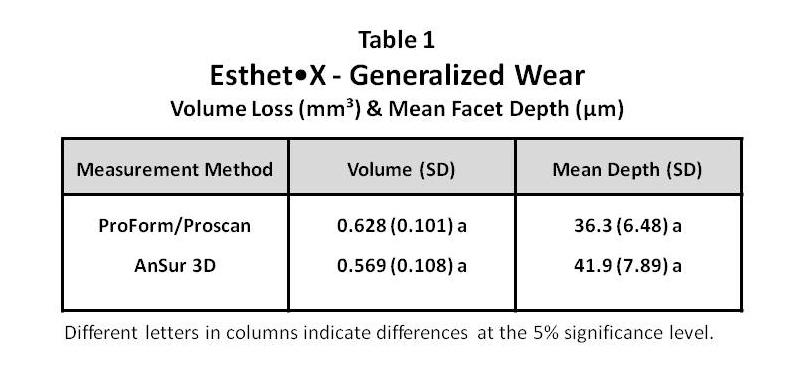Contact and non-contact profilometers have been used to assess wear of dental materials subjected to various wear challenges in the laboratory. Wear measurement software is generally system specific. Objectives: The purpose of this study was to examine and compare wear measurements using two different software systems with a non-contact profilometer. Methods: Twelve specimens each were fabricated for generalized wear simulation using two resin composite materials: Esthet•X (E) and Filtek Supreme Plus (SP). The specimens were subjected to 400,000 cycles in a Leinfelder-Suzuki wear simulator (maximum load of 80N) using flat stainless steel antagonists in a water slurry of PMMA beads. Before and after data sets were generated using a non-contact profilometer (Proscan 2000) with Proscan software. Volume loss (VL) and mean facet depth (FD) were then determined with the data sets using two software systems: 1) ProForm and Proscan (Scantron Industrial Products, Ltd, Taunton, England) and 2) AnSur 3D (Minnesota Dental Research Center for Biomaterials and Biomechanics, University of Minnesota, Minneapolis MN, USA). Wear measurements (VL and FD) determined with the two software systems for each of the resin composite materials (E and SP) were compared with a t-test and Pearson's correlation. Results:
Wear measurements with the two assessment methods of VL and FD for the two resin composites (E and SP) were not different at the 5% significance level. Pearson's correlation (r) of VL and FD for the two software systems were as follows: E - VL 0.987 and FD 0.985; SP - VL 0.913 and FD 0.987. Wear values (simulated generalized wear) with the AnSur 3D system trended lower for volume loss and higher for mean facet depth when compared to ProForm/Proscan values. Conclusions: Wear measurements of volume loss and mean facet depth of two resin composite materials were each statistically similar using two assessment methods for determining wear.
Keywords: Composites and Wear
![[ Visit AADR's Website ]](images/banner.jpg)

